Nursing: Applying Governance in Collaborative Patient Care
VerifiedAdded on 2023/04/25
|6
|1226
|212
Essay
AI Summary
This essay discusses the application of key principles in nursing practice, drawing from experiences in a nursing placement. It highlights the importance of interprofessional health care team collaboration for achieving positive patient outcomes and reducing adverse drug events, demonstrating skills such as communication, accountability, and mutual respect through examples like medication error prevention and developing patient-centered care plans for diabetic patients. The essay also addresses clinical governance by focusing on identifying hazards and creating a safe environment, citing instances of preventing patient falls and detecting wrong-site surgery markings. Furthermore, it examines self-governance, emphasizing professional conduct, ethical boundaries, and continuous professional development, illustrated by maintaining professional relationships with patients and pursuing further training in medication administration. The essay integrates relevant governance frameworks like the Registered Nurse Standards for Practice and the NSQHS Standards, linking theory and practice to inform future nursing practice. Desklib offers this and many other solved assignments for students.
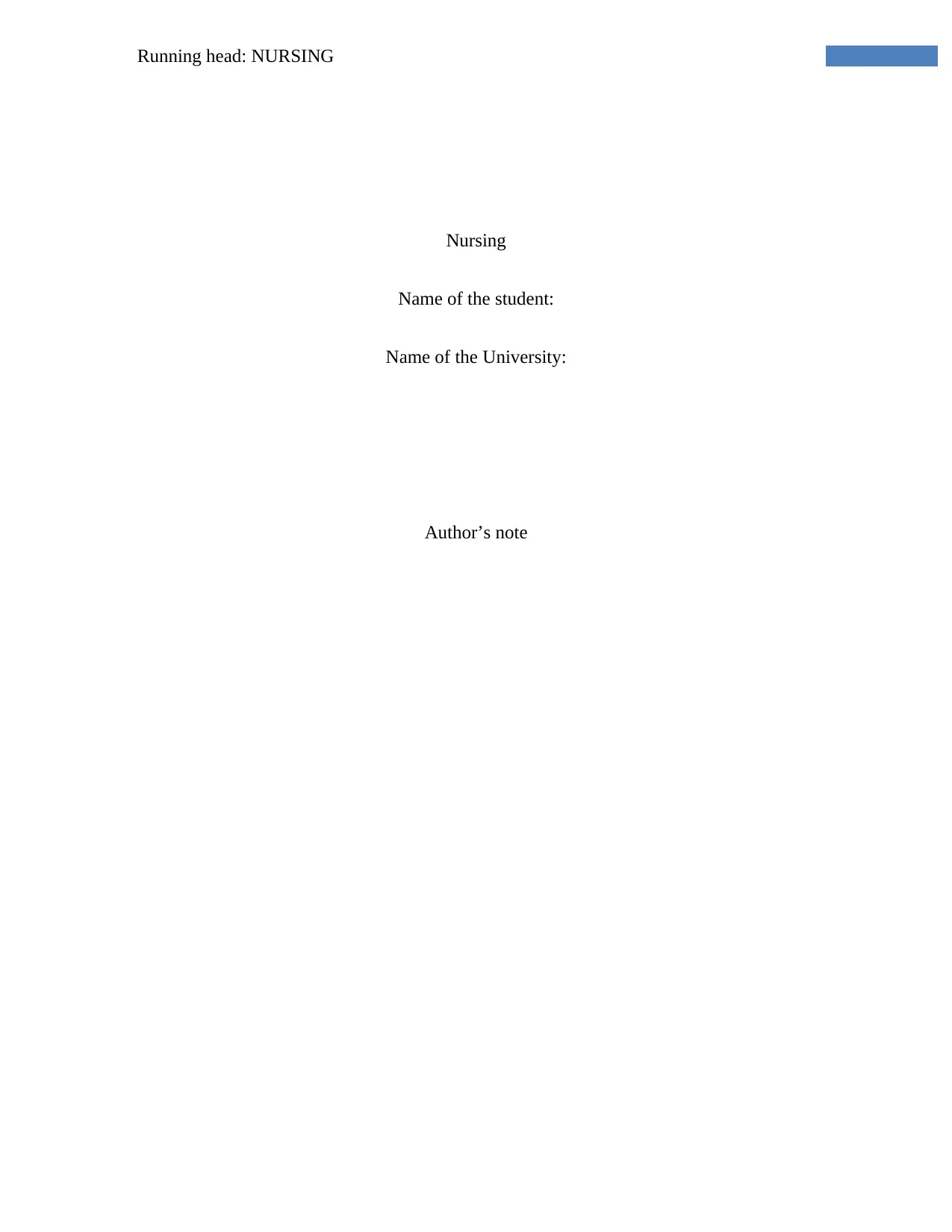
Running head: NURSING
Nursing
Name of the student:
Name of the University:
Author’s note
Nursing
Name of the student:
Name of the University:
Author’s note
Paraphrase This Document
Need a fresh take? Get an instant paraphrase of this document with our AI Paraphraser
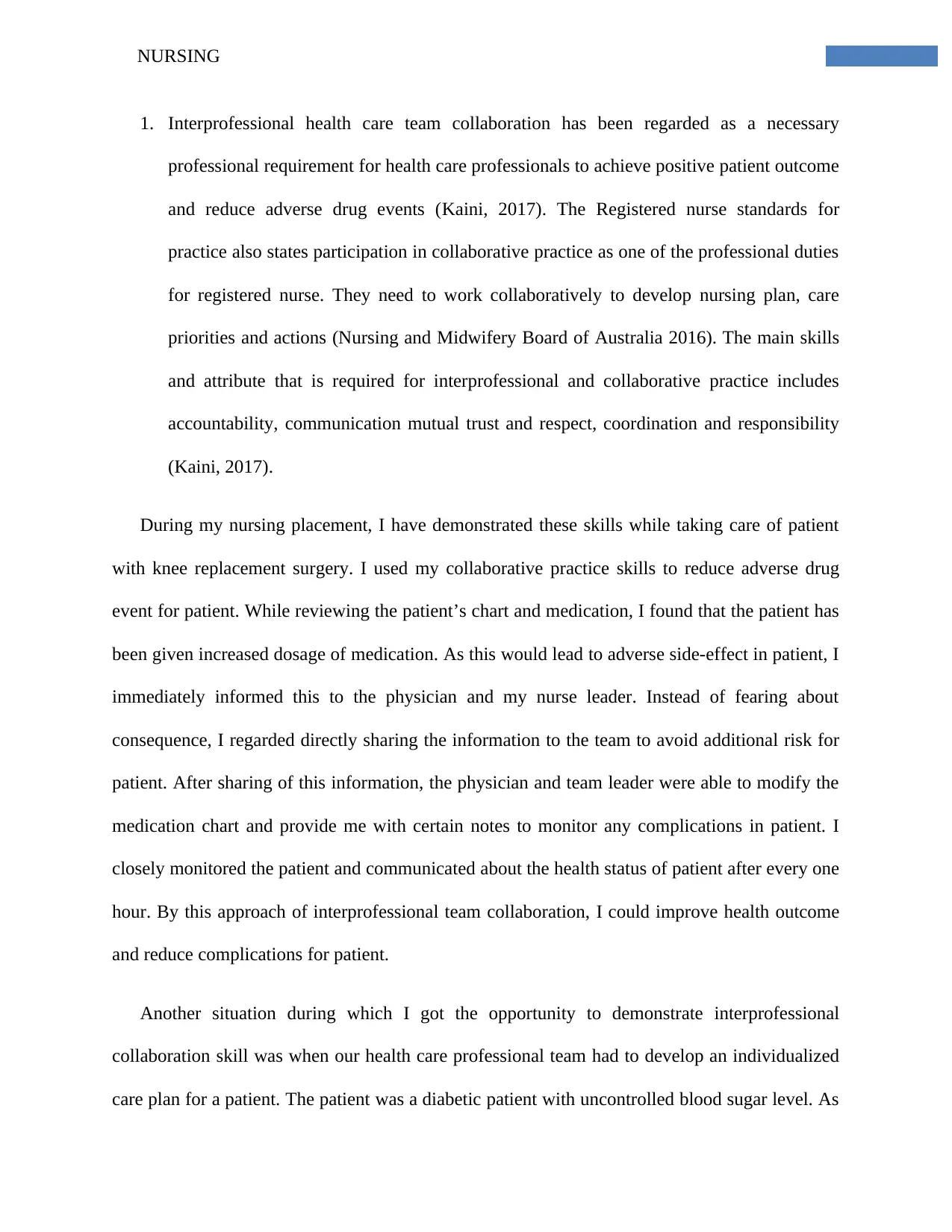
NURSING
1. Interprofessional health care team collaboration has been regarded as a necessary
professional requirement for health care professionals to achieve positive patient outcome
and reduce adverse drug events (Kaini, 2017). The Registered nurse standards for
practice also states participation in collaborative practice as one of the professional duties
for registered nurse. They need to work collaboratively to develop nursing plan, care
priorities and actions (Nursing and Midwifery Board of Australia 2016). The main skills
and attribute that is required for interprofessional and collaborative practice includes
accountability, communication mutual trust and respect, coordination and responsibility
(Kaini, 2017).
During my nursing placement, I have demonstrated these skills while taking care of patient
with knee replacement surgery. I used my collaborative practice skills to reduce adverse drug
event for patient. While reviewing the patient’s chart and medication, I found that the patient has
been given increased dosage of medication. As this would lead to adverse side-effect in patient, I
immediately informed this to the physician and my nurse leader. Instead of fearing about
consequence, I regarded directly sharing the information to the team to avoid additional risk for
patient. After sharing of this information, the physician and team leader were able to modify the
medication chart and provide me with certain notes to monitor any complications in patient. I
closely monitored the patient and communicated about the health status of patient after every one
hour. By this approach of interprofessional team collaboration, I could improve health outcome
and reduce complications for patient.
Another situation during which I got the opportunity to demonstrate interprofessional
collaboration skill was when our health care professional team had to develop an individualized
care plan for a patient. The patient was a diabetic patient with uncontrolled blood sugar level. As
1. Interprofessional health care team collaboration has been regarded as a necessary
professional requirement for health care professionals to achieve positive patient outcome
and reduce adverse drug events (Kaini, 2017). The Registered nurse standards for
practice also states participation in collaborative practice as one of the professional duties
for registered nurse. They need to work collaboratively to develop nursing plan, care
priorities and actions (Nursing and Midwifery Board of Australia 2016). The main skills
and attribute that is required for interprofessional and collaborative practice includes
accountability, communication mutual trust and respect, coordination and responsibility
(Kaini, 2017).
During my nursing placement, I have demonstrated these skills while taking care of patient
with knee replacement surgery. I used my collaborative practice skills to reduce adverse drug
event for patient. While reviewing the patient’s chart and medication, I found that the patient has
been given increased dosage of medication. As this would lead to adverse side-effect in patient, I
immediately informed this to the physician and my nurse leader. Instead of fearing about
consequence, I regarded directly sharing the information to the team to avoid additional risk for
patient. After sharing of this information, the physician and team leader were able to modify the
medication chart and provide me with certain notes to monitor any complications in patient. I
closely monitored the patient and communicated about the health status of patient after every one
hour. By this approach of interprofessional team collaboration, I could improve health outcome
and reduce complications for patient.
Another situation during which I got the opportunity to demonstrate interprofessional
collaboration skill was when our health care professional team had to develop an individualized
care plan for a patient. The patient was a diabetic patient with uncontrolled blood sugar level. As
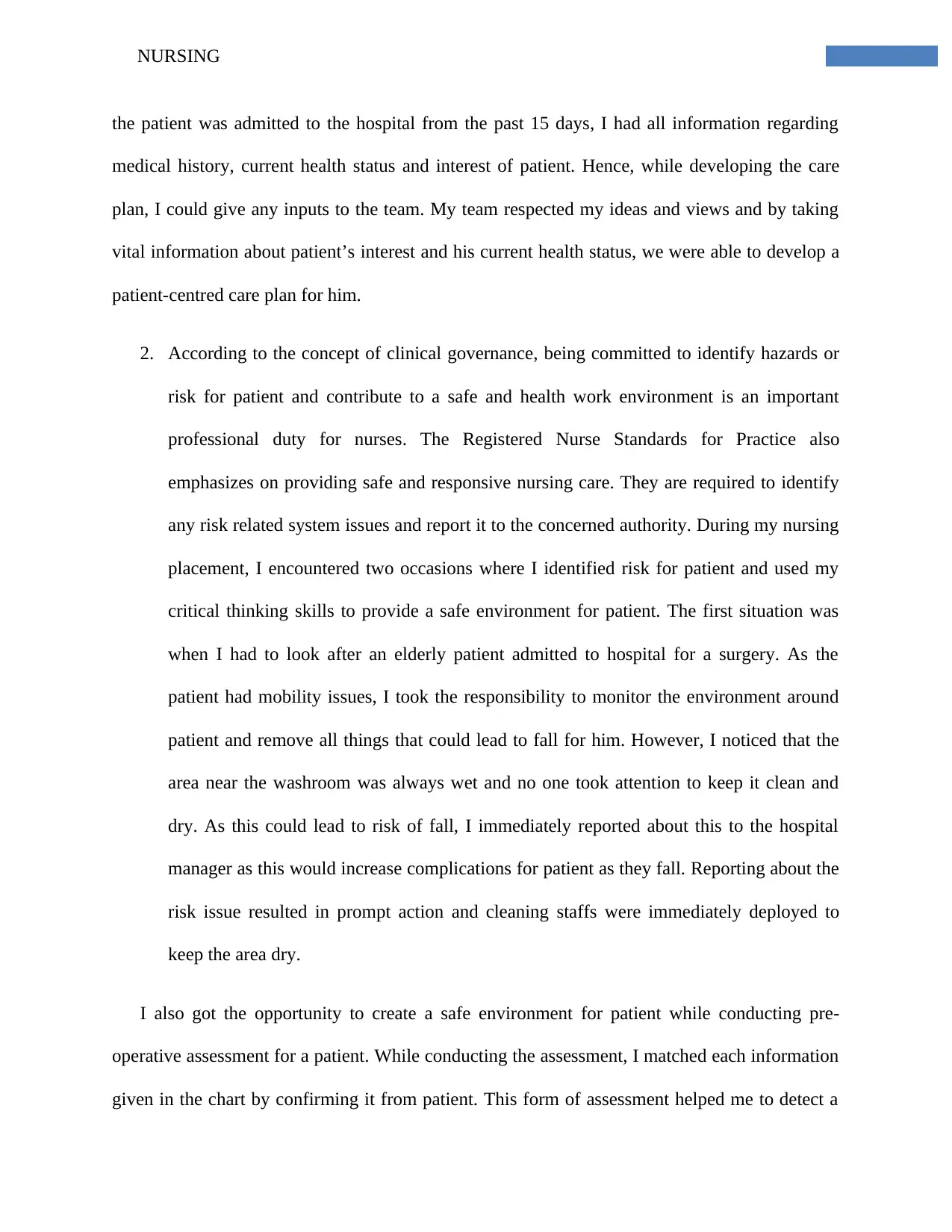
NURSING
the patient was admitted to the hospital from the past 15 days, I had all information regarding
medical history, current health status and interest of patient. Hence, while developing the care
plan, I could give any inputs to the team. My team respected my ideas and views and by taking
vital information about patient’s interest and his current health status, we were able to develop a
patient-centred care plan for him.
2. According to the concept of clinical governance, being committed to identify hazards or
risk for patient and contribute to a safe and health work environment is an important
professional duty for nurses. The Registered Nurse Standards for Practice also
emphasizes on providing safe and responsive nursing care. They are required to identify
any risk related system issues and report it to the concerned authority. During my nursing
placement, I encountered two occasions where I identified risk for patient and used my
critical thinking skills to provide a safe environment for patient. The first situation was
when I had to look after an elderly patient admitted to hospital for a surgery. As the
patient had mobility issues, I took the responsibility to monitor the environment around
patient and remove all things that could lead to fall for him. However, I noticed that the
area near the washroom was always wet and no one took attention to keep it clean and
dry. As this could lead to risk of fall, I immediately reported about this to the hospital
manager as this would increase complications for patient as they fall. Reporting about the
risk issue resulted in prompt action and cleaning staffs were immediately deployed to
keep the area dry.
I also got the opportunity to create a safe environment for patient while conducting pre-
operative assessment for a patient. While conducting the assessment, I matched each information
given in the chart by confirming it from patient. This form of assessment helped me to detect a
the patient was admitted to the hospital from the past 15 days, I had all information regarding
medical history, current health status and interest of patient. Hence, while developing the care
plan, I could give any inputs to the team. My team respected my ideas and views and by taking
vital information about patient’s interest and his current health status, we were able to develop a
patient-centred care plan for him.
2. According to the concept of clinical governance, being committed to identify hazards or
risk for patient and contribute to a safe and health work environment is an important
professional duty for nurses. The Registered Nurse Standards for Practice also
emphasizes on providing safe and responsive nursing care. They are required to identify
any risk related system issues and report it to the concerned authority. During my nursing
placement, I encountered two occasions where I identified risk for patient and used my
critical thinking skills to provide a safe environment for patient. The first situation was
when I had to look after an elderly patient admitted to hospital for a surgery. As the
patient had mobility issues, I took the responsibility to monitor the environment around
patient and remove all things that could lead to fall for him. However, I noticed that the
area near the washroom was always wet and no one took attention to keep it clean and
dry. As this could lead to risk of fall, I immediately reported about this to the hospital
manager as this would increase complications for patient as they fall. Reporting about the
risk issue resulted in prompt action and cleaning staffs were immediately deployed to
keep the area dry.
I also got the opportunity to create a safe environment for patient while conducting pre-
operative assessment for a patient. While conducting the assessment, I matched each information
given in the chart by confirming it from patient. This form of assessment helped me to detect a
⊘ This is a preview!⊘
Do you want full access?
Subscribe today to unlock all pages.

Trusted by 1+ million students worldwide
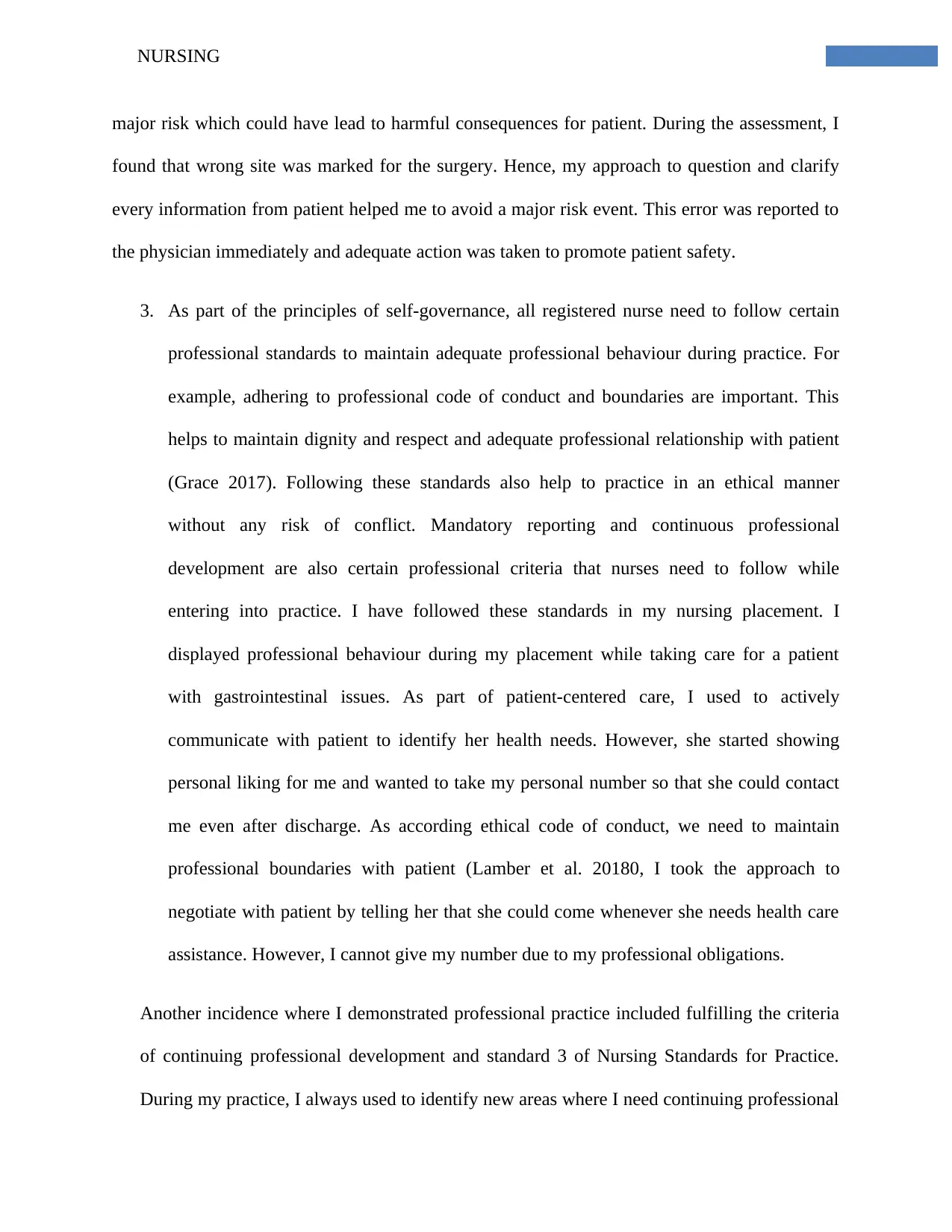
NURSING
major risk which could have lead to harmful consequences for patient. During the assessment, I
found that wrong site was marked for the surgery. Hence, my approach to question and clarify
every information from patient helped me to avoid a major risk event. This error was reported to
the physician immediately and adequate action was taken to promote patient safety.
3. As part of the principles of self-governance, all registered nurse need to follow certain
professional standards to maintain adequate professional behaviour during practice. For
example, adhering to professional code of conduct and boundaries are important. This
helps to maintain dignity and respect and adequate professional relationship with patient
(Grace 2017). Following these standards also help to practice in an ethical manner
without any risk of conflict. Mandatory reporting and continuous professional
development are also certain professional criteria that nurses need to follow while
entering into practice. I have followed these standards in my nursing placement. I
displayed professional behaviour during my placement while taking care for a patient
with gastrointestinal issues. As part of patient-centered care, I used to actively
communicate with patient to identify her health needs. However, she started showing
personal liking for me and wanted to take my personal number so that she could contact
me even after discharge. As according ethical code of conduct, we need to maintain
professional boundaries with patient (Lamber et al. 20180, I took the approach to
negotiate with patient by telling her that she could come whenever she needs health care
assistance. However, I cannot give my number due to my professional obligations.
Another incidence where I demonstrated professional practice included fulfilling the criteria
of continuing professional development and standard 3 of Nursing Standards for Practice.
During my practice, I always used to identify new areas where I need continuing professional
major risk which could have lead to harmful consequences for patient. During the assessment, I
found that wrong site was marked for the surgery. Hence, my approach to question and clarify
every information from patient helped me to avoid a major risk event. This error was reported to
the physician immediately and adequate action was taken to promote patient safety.
3. As part of the principles of self-governance, all registered nurse need to follow certain
professional standards to maintain adequate professional behaviour during practice. For
example, adhering to professional code of conduct and boundaries are important. This
helps to maintain dignity and respect and adequate professional relationship with patient
(Grace 2017). Following these standards also help to practice in an ethical manner
without any risk of conflict. Mandatory reporting and continuous professional
development are also certain professional criteria that nurses need to follow while
entering into practice. I have followed these standards in my nursing placement. I
displayed professional behaviour during my placement while taking care for a patient
with gastrointestinal issues. As part of patient-centered care, I used to actively
communicate with patient to identify her health needs. However, she started showing
personal liking for me and wanted to take my personal number so that she could contact
me even after discharge. As according ethical code of conduct, we need to maintain
professional boundaries with patient (Lamber et al. 20180, I took the approach to
negotiate with patient by telling her that she could come whenever she needs health care
assistance. However, I cannot give my number due to my professional obligations.
Another incidence where I demonstrated professional practice included fulfilling the criteria
of continuing professional development and standard 3 of Nursing Standards for Practice.
During my practice, I always used to identify new areas where I need continuing professional
Paraphrase This Document
Need a fresh take? Get an instant paraphrase of this document with our AI Paraphraser
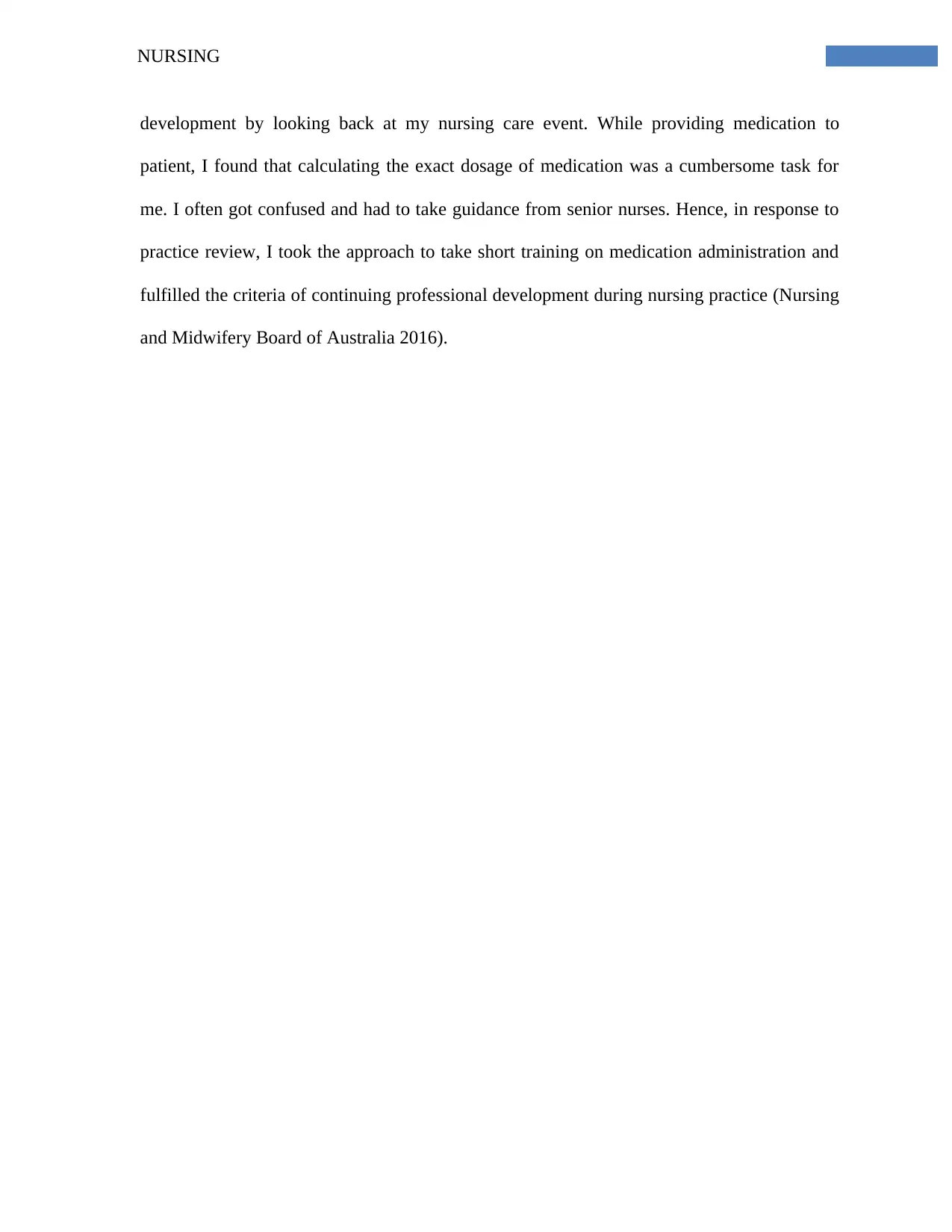
NURSING
development by looking back at my nursing care event. While providing medication to
patient, I found that calculating the exact dosage of medication was a cumbersome task for
me. I often got confused and had to take guidance from senior nurses. Hence, in response to
practice review, I took the approach to take short training on medication administration and
fulfilled the criteria of continuing professional development during nursing practice (Nursing
and Midwifery Board of Australia 2016).
development by looking back at my nursing care event. While providing medication to
patient, I found that calculating the exact dosage of medication was a cumbersome task for
me. I often got confused and had to take guidance from senior nurses. Hence, in response to
practice review, I took the approach to take short training on medication administration and
fulfilled the criteria of continuing professional development during nursing practice (Nursing
and Midwifery Board of Australia 2016).
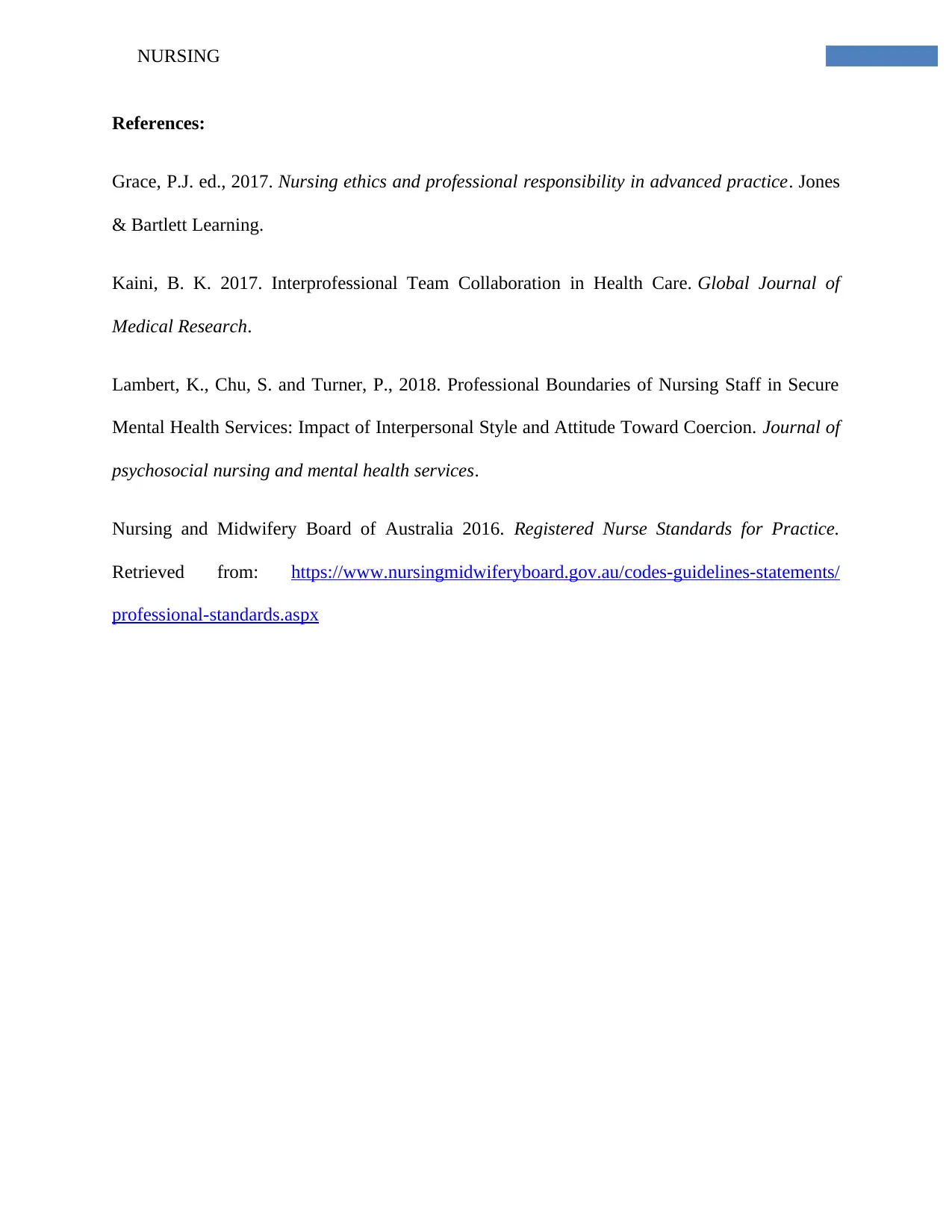
NURSING
References:
Grace, P.J. ed., 2017. Nursing ethics and professional responsibility in advanced practice. Jones
& Bartlett Learning.
Kaini, B. K. 2017. Interprofessional Team Collaboration in Health Care. Global Journal of
Medical Research.
Lambert, K., Chu, S. and Turner, P., 2018. Professional Boundaries of Nursing Staff in Secure
Mental Health Services: Impact of Interpersonal Style and Attitude Toward Coercion. Journal of
psychosocial nursing and mental health services.
Nursing and Midwifery Board of Australia 2016. Registered Nurse Standards for Practice.
Retrieved from: https://www.nursingmidwiferyboard.gov.au/codes-guidelines-statements/
professional-standards.aspx
References:
Grace, P.J. ed., 2017. Nursing ethics and professional responsibility in advanced practice. Jones
& Bartlett Learning.
Kaini, B. K. 2017. Interprofessional Team Collaboration in Health Care. Global Journal of
Medical Research.
Lambert, K., Chu, S. and Turner, P., 2018. Professional Boundaries of Nursing Staff in Secure
Mental Health Services: Impact of Interpersonal Style and Attitude Toward Coercion. Journal of
psychosocial nursing and mental health services.
Nursing and Midwifery Board of Australia 2016. Registered Nurse Standards for Practice.
Retrieved from: https://www.nursingmidwiferyboard.gov.au/codes-guidelines-statements/
professional-standards.aspx
⊘ This is a preview!⊘
Do you want full access?
Subscribe today to unlock all pages.

Trusted by 1+ million students worldwide
1 out of 6
Related Documents
Your All-in-One AI-Powered Toolkit for Academic Success.
+13062052269
info@desklib.com
Available 24*7 on WhatsApp / Email
![[object Object]](/_next/static/media/star-bottom.7253800d.svg)
Unlock your academic potential
Copyright © 2020–2025 A2Z Services. All Rights Reserved. Developed and managed by ZUCOL.





